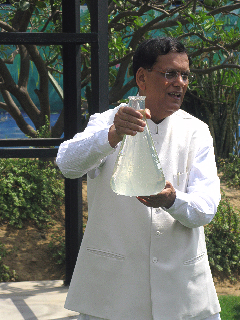
Dr. Bindeshwar Pathak displays a beaker of colorless, odorless, pathogen-free liquid manure distilled from human excreta. The fertilizer is created using a low-tech, five-step process that includes sand and charcoal filtering and exposure to ultraviolet rays. Methane is captured and burned as cooking fuel.
Kevin Ferguson
DELHI, India — Ah, the Sulabh International Museum of Toilets! How’s that for a place to take the wife and kids on a Sunday afternoon?
It’s hard not to smirk when this museum’s name is first mentioned. It sounds like a roadside attraction, something you find just a ways down the road from the World’s Oldest Rug (St. Augustine, Fla.) and the World’s Largest Ball of Twine (Cawker City, Kan.).
But when you visit the museum, the smirk evaporates. It’s not the museum itself — a rather small collection of lavatory oddities that includes a replica of Louis XIV’s throne with a hidden commode that allowed the monarch to evacuate his bowels while giving audience — that changes a visitor’s mind. Instead, it’s the trip to the museum through the streets of Delhi, India. There, where 18 percent of the population still defecates openly and where 20 percent of children who die under the age of five do so from water-borne diseases, the true purpose of the museum becomes evident: It’s a way to lure in visitors and introduce them to the Sulabh International Social Service Organization and its Sulabh Sanitation Movement.
Sulabh, which translates to “simple” in Hindi, is the brainchild of Dr. Bindeshwar Pathak, a Brahmin snoot-cum-egalitarian who has transformed the lives of millions of impoverished people across South Asia with the introduction of low-cost composting latrines. Because they require little or no water to operate, the latrines solve the problem faced by poor cities and rural areas alike: no sewage system.
Sulabh has also rescued and retrained more than 120,000 “scavengers,” members of the low-ranking Dalit caste in Indian society whose lifelong job is to empty household latrines, carrying the contents away in buckets on their heads. The practice is now illegal but continues in many rural areas. Sulabh’s organization offers scavenger families vocational training and formal education.
“I am a pragmatist,” says Pathak, when asked about the prospects of truly ending the practice. “What we are saying is that all castes are the same. Brahman can sit down with the Dalit.” That includes the dining room and the bathroom.
Pathak’s notions are, indeed, simple. The toilets come in 11 models, ranging from a handsome bamboo and mortar model that costs 1,600 rupees ($31), to the crème de la crème — a cement, brick and fiberglass dandy that costs about 14,000 rupees ($275). Each uses the same basic technology: two pits of varying size that are used alternately. When one pit is full, the incoming waste is diverted into the second pit. In about two years, natural processes transform the sludge, leaving it almost dry and pathogen free, thus safe for handling as manure. Pathak has also designed biogas cooking systems, which capture the methane from human excreta and pipe it right back into the kitchen stove, and water filtering systems that reclaim effluent for irrigation.
Simple? Yes. But in India, a nuclear power on one hand but also a place where it’s nearly impossible to find around-the-clock water service, simple is seldom easy. So, any progress in water and sanitation takes on special meeting.
The Stockholm International Water Institute (SIWI) recognized that much two weeks ago when it awarded Pathak the 2009 Stockholm Water Prize. SIWI is the world’s pre-eminent research and advocacy organization in the sector, and winning the prize is comparable to capturing a Nobel. King Carl XVI Gustaf of Sweden will present the Water Prize at a royal banquet in August.

Pathak models a low-cost toilet made of bamboo, mud and mortar. Price: 1,600 rupees ($31), including jute door.
Kevin Ferguson
“The results of Dr. Pathak’s endeavors constitute one of the most amazing examples of how one person can impact the well being of millions,” the Stockholm Water Prize nominating committee states in its citation. All told, 1.2 million residences and buildings use the Sulabh pour-flush toilets, and more than 10 million people each day use Sulabh-design public toilets, including the one just beside the museum’s entrance.
Pathak’s work remains just a drop in the chamber pot, however. More than 2.6 billion people in developing countries — the vast majority in South Asia — have no access to a toilet. And Sulabh’s message of urgency, though well known and lauded by humanitarians, doesn’t always penetrate the hearts and minds of policymakers in India. The result, according to the World Bank’s Water and Sanitation Program, is rank: 80 percent of surface water pollution in urban India is due to municipal sewage.
“Enough with holding a candle in the darkness,” says Gaurab Chandra, a coordinator at Sulabh International, referring to the exhortation attributed to Mahatma Gandhi that it is better to light a single candle than to curse the darkness. “We need a Halogen lamp here. Twenty of them.”




